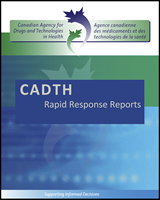Primary postpartum hemorrhage (PPH) is defined as blood loss of ≥ 500 mL within 24 hours after giving birth. PPH is associated with considerable morbidity, and is a leading cause of maternal mortality in Canada and worldwide. Approximately 4.8% of pregnant women in Canada experience PPH, and PPH results in approximately 1.5 maternal deaths per 100,000 live births.
Fluid resuscitation is an important component of managing patients with PPH. Crystalloids and colloids are intravenous fluids used to expand the volume within the circulatory system in situations of blood loss. Examples of crystalloids include normal saline (sodium chloride 0.9%), 5% dextrose in water, and Ringer’s lactate. Colloids differ from crystalloids in that they contain insoluble molecules which act to preserve osmotic pressure within the blood, whereas crystalloids reduce osmotic pressure due to hemodilution. Examples of colloids include albumin, dextran, gelatin, and hydroxyethyl starch.
Hydroxyethyl starch is a form of plant starch that has been partially hydrolyzed to extend the duration of action of the molecule. Although hydroxyethyl starch has been used for a number of years in patients requiring fluid resuscitation, hydroxyethyl starch appears to increase the risk of a number of adverse events including mortality, acute kidney injury, refractory pruritus, and hemorrhage relative to crystalloids and other colloids. However, these studies included patients undergoing cardiac surgery and patients admitted to intensive care. It is unclear whether these adverse events are increased in patients with PPH.
The purpose of this Rapid Response report is to identify studies and clinical practice guidelines evaluating the clinical effectiveness, safety, and recommendations regarding the use of hydroxyethyl starch in patients with PPH.
Disclaimer: The Rapid Response Service is an information service for those involved in planning and providing health care in Canada. Rapid responses are based on a limited literature search and are not comprehensive, systematic reviews. The intent is to provide a list of sources of the best evidence on the topic that CADTH could identify using all reasonable efforts within the time allowed. Rapid responses should be considered along with other types of information and health care considerations. The information included in this response is not intended to replace professional medical advice, nor should it be construed as a recommendation for or against the use of a particular health technology. Readers are also cautioned that a lack of good quality evidence does not necessarily mean a lack of effectiveness particularly in the case of new and emerging health technologies, for which little information can be found, but which may in future prove to be effective. While CADTH has taken care in the preparation of the report to ensure that its contents are accurate, complete and up to date, CADTH does not make any guarantee to that effect. CADTH is not liable for any loss or damages resulting from use of the information in the report.

